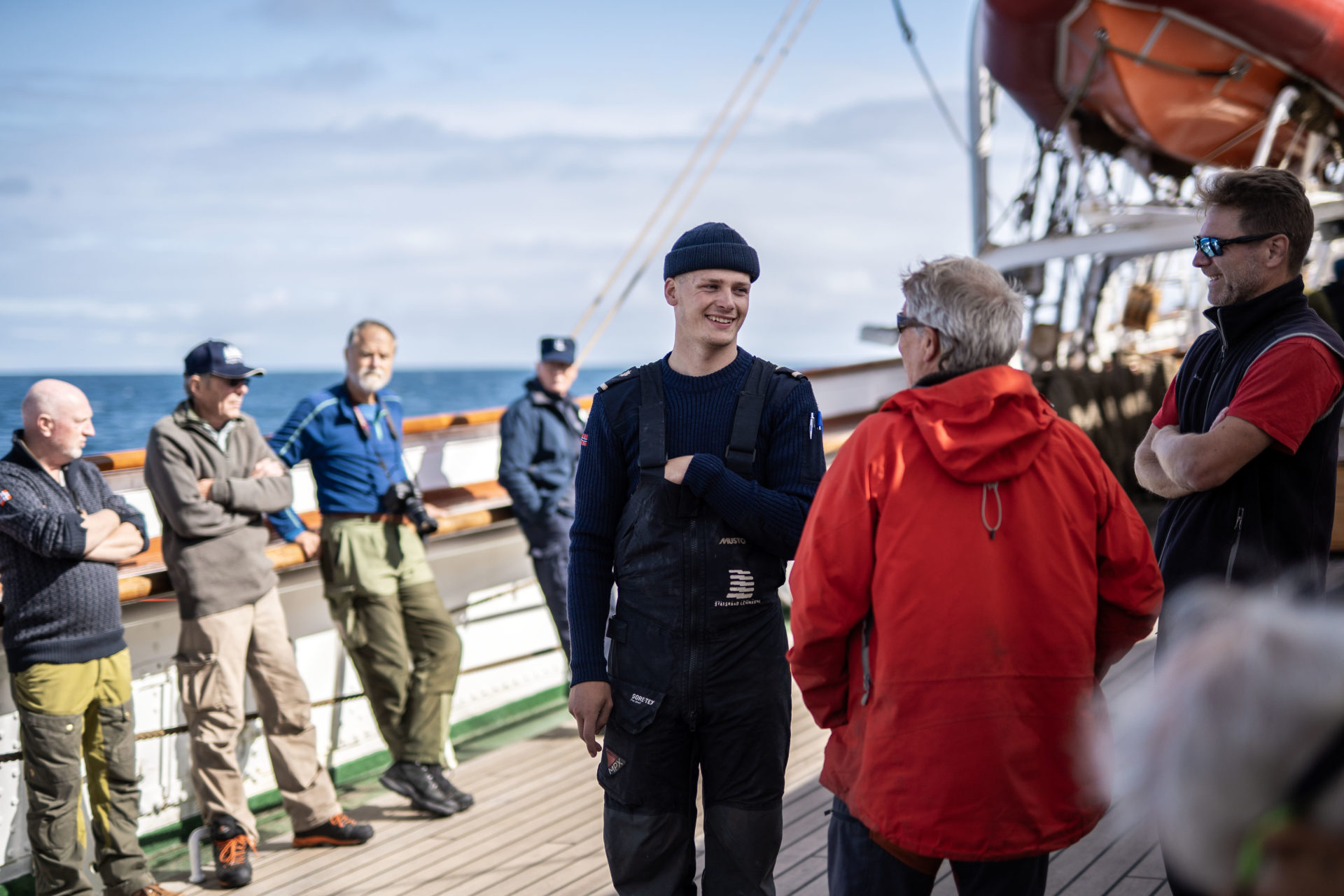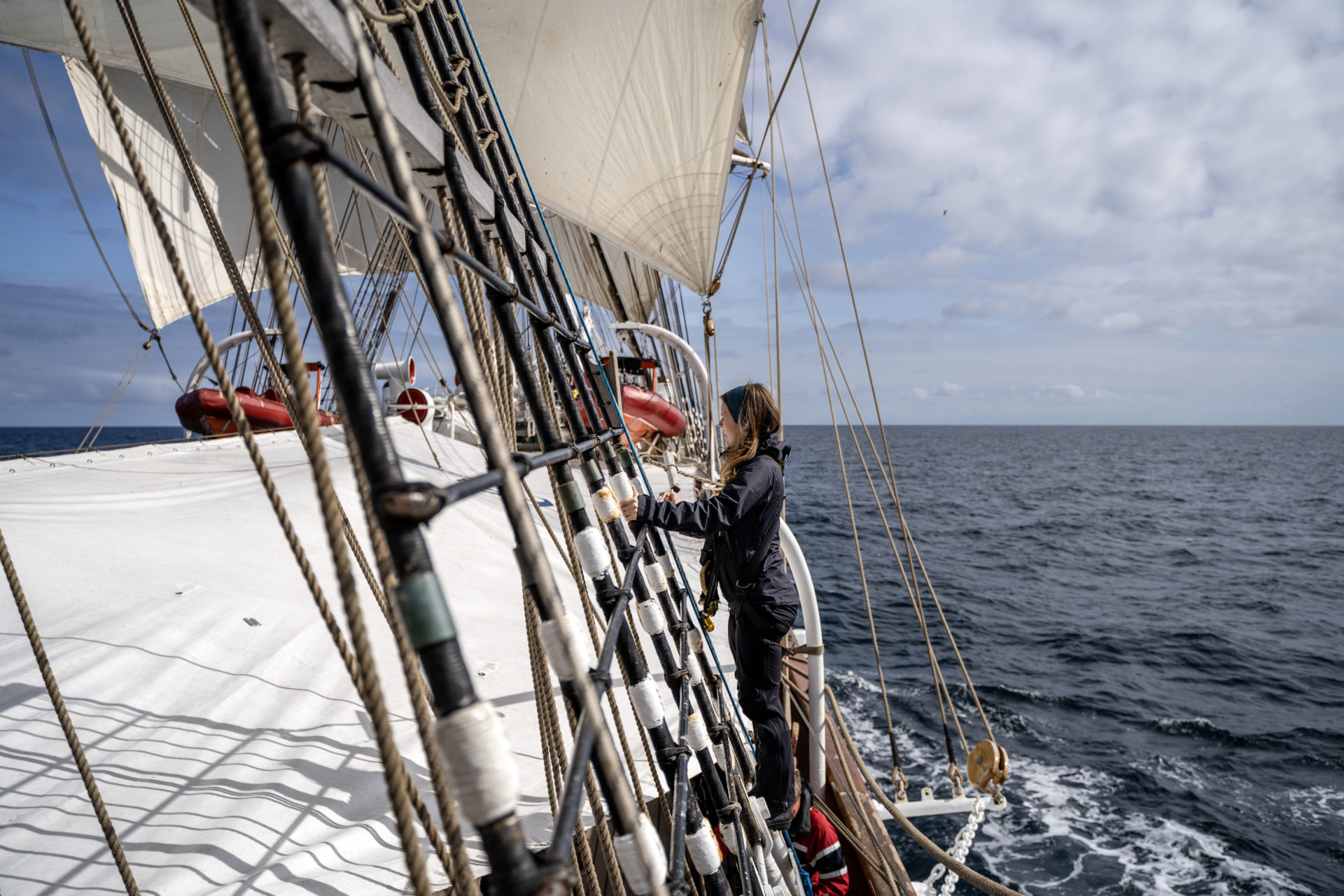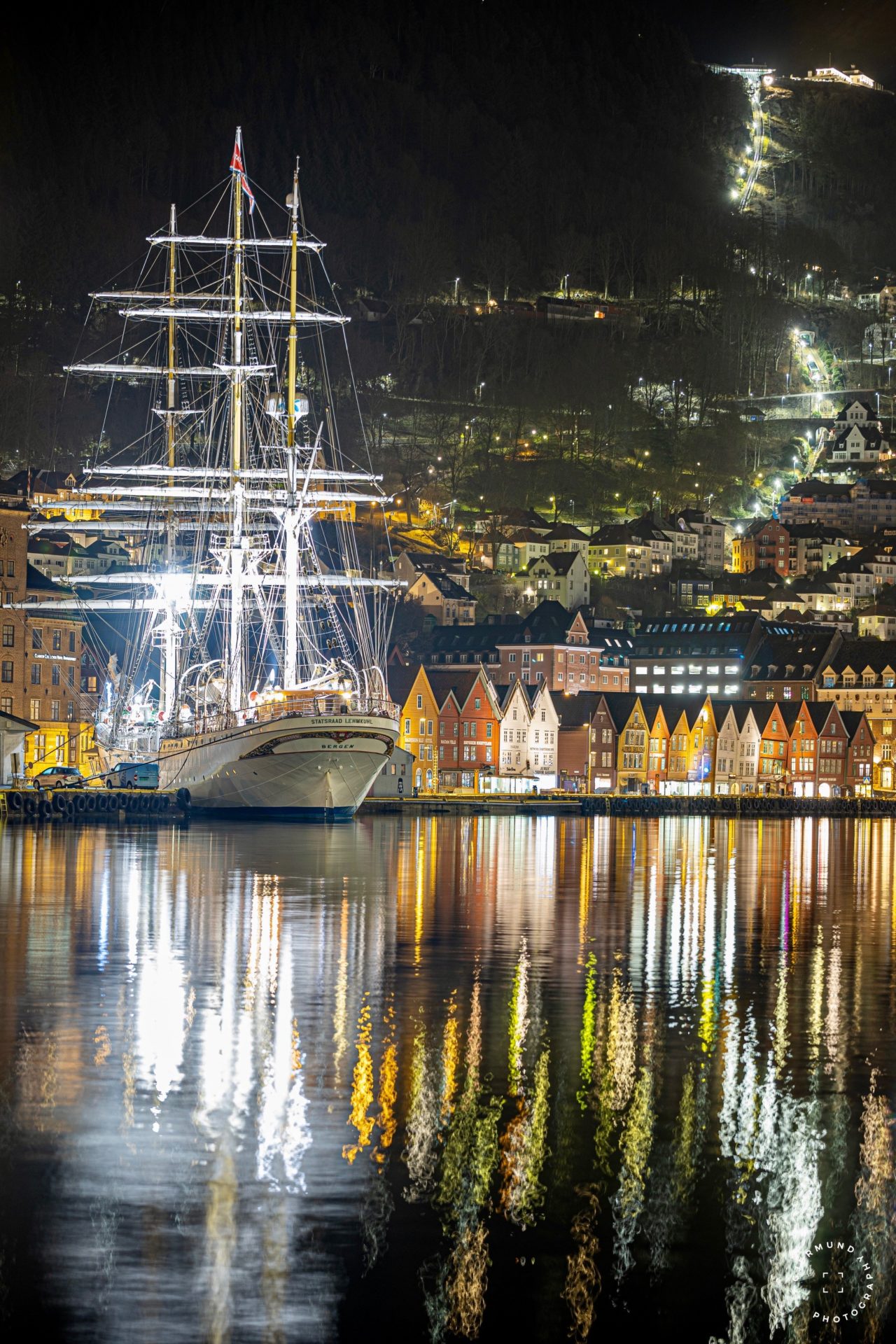30+ climate scientists crewing a century-old tall ship, 6 days in the North Sea: how can one voyage help them to help the Ocean? David Eades shared the experience.
For ocean scientists committed to protecting the seas, the threats from climate change, over-fishing, mineral exploitation, dumping and general negligence towards our Ocean are a cause of constant anxiety. Often it’s fuelled by the research they are doing in their individual fields, and their relative inability to change the behaviour of political leaders, industries, the public. They often work in their own sectors and silos, where the discoveries they make and the data they can provide add up to just tiny pin-pricks on the rhino hide of political or public opinion. But what if they all learned to pull together? One man had an idea how to make that happen.
By David Eades,
former BBC TV and Radio News Anchor
with a special interest in Protection of the Ocean.
It had to be the rum. On a hearty evening in April, Haakon Vatle took one of his finest liquors off the top shelf in the Lehmkuhl bar in Bergen harbour. As he liberally filled glasses, he was already intoxicated by the return of his ship to shore after a 20-month circumnavigation of the planet. The Statsraad Lehmkuhl is a thing of beauty: a 109-year old three-mast, square sail tall ship, one of the last of its kind to be built, and now proving its sustainability credentials as a research vessel and a cheerleader for a cleaner world.
For Vatle, the ship represents hope and inspiration. Embark on one voyage with the Lehmkuhl and you will never see the seas in quite the same light again. It will also instil a realisation that you can achieve precious little alone – and yet sail an ocean if you work together.
So where better to gather a group of scientists than on the vessel he once crewed, captained – and whose foundation he now runs?
 Boarding in Bergen. Photo: Malin Kvamme
Boarding in Bergen. Photo: Malin Kvamme
The Lehmkuhl would push out from Norway’s west coast in the direction of the Scottish Islands, open her sails, and open the minds of the people best placed to diagnose and problem-solve together, to highlight the fragility of this vast blue mass which is home to some 94% of our planet’s wildlife.
Rum in sufficient quantity can encourage anybody to sign up to anything. But if they did need further persuading, the Statsraad Lehmkuhl is like a sweetie shop for scientists, kitted out with umpteen kits and gadgets, gathering data from sonar echoes to the seawater’s DNA. A wave sensor at the very front of the ship, a plankton net, microplastics filter unit, a device for measuring conductivity, temperature and depth. And of course CO2 levels in the water and on the ship. Plus the wherewithal to transmit all this in real time via satellite.
Vatle himself is no scientist. He is a one-off. An ambitious, clear-sighted CEO on a mission to guarantee the future of this vessel. He is also a seafarer’s dream: a lover of the open seas, with a voice and a personality to pull his crew along with him. He is the shantyman on board, with the lung capacity and drive to turn the most reluctant passenger into a into full blown chorister.
Four months after that boozy evening, the ropes, the sails, the provisions (and the sick bins) were ready and awaiting a ‘watch’ of scientists and academics, oceanographers, meteorologists, satellite mission scientists, marine biologists and conservationists, forecasters, remote sensing experts. And into the mix came policy planners, economic experts, service providers, shipping engineers, a journalist and a weather presenter. Some of them – oceanographers included – had never spent a week on a ship. Others were hardy sailors. A mixed bag with different scientific roles and goals. And with many different opinions as to the right way to navigate a course towards real progress in protection of the Ocean. They did at least share a common destination, beyond Shetland: the 3rd UN Ocean Conference, to be hosted by Nice in 2025 represents the next big chance to influence the world’s leaders in ocean protection.
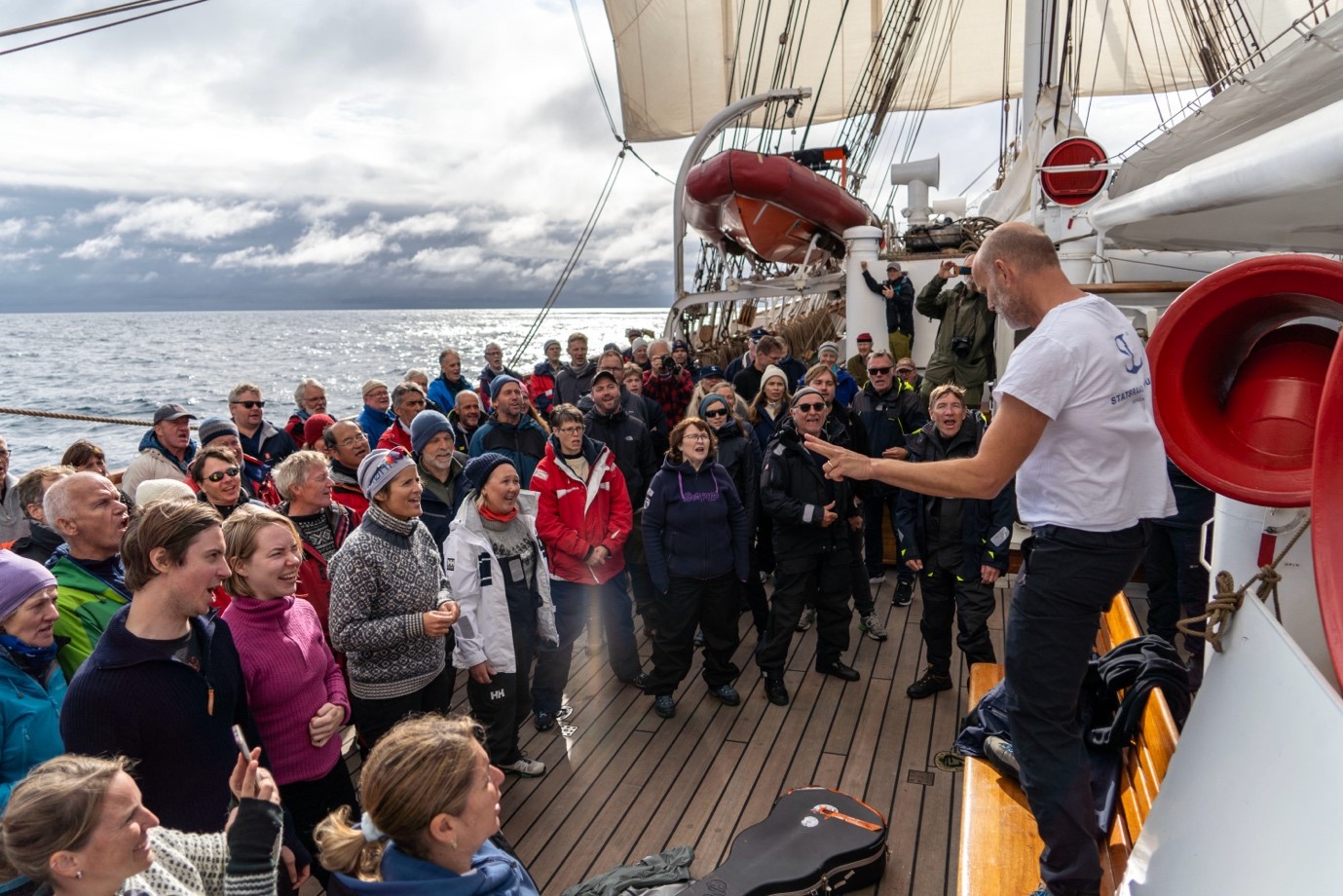
Haakon Vatle briefing the crew. Photo: Malin Kvamme
There is a fascinating parallel between the workings of a ship and the workings of a major international conference. In both areas, the chain of command is definite, if not always obvious. The first instruction to the scientist-deckhands on board the Lehmkuhl was simple: “Take no initiative. None. At all”. That was the clear order barked out by the 21-year old watch leader, Christian Hetty. Ask all the questions you like, but don’t make a decision for yourself. Don’t coil a rope just because it’s lying on the deck. Report it if you must, and do it if you’re told to, but DON’T take the initiative.
How apt for those who have witnessed, even shared in the negotiating process towards a new international declaration on climate or the environment. Leave it to your superior and ultimately the captain (one step above God in the sailing ship’s hierarchy). And it is a long way from deckhand to captain’s cabin, with much nervousness about pushing ideas up the chain. Initiatives – if they do make it to the top table – can take a very long time to make it back down to real change on deck.
And remember: you are part of a crew. No room here for individualism, or for silos, for oceanographers to congregate in their own comfort corner. This is all-for-one territory, a long way from the isolating shores of so much scientific research. This is a time to share information, workloads, targets, strategies.
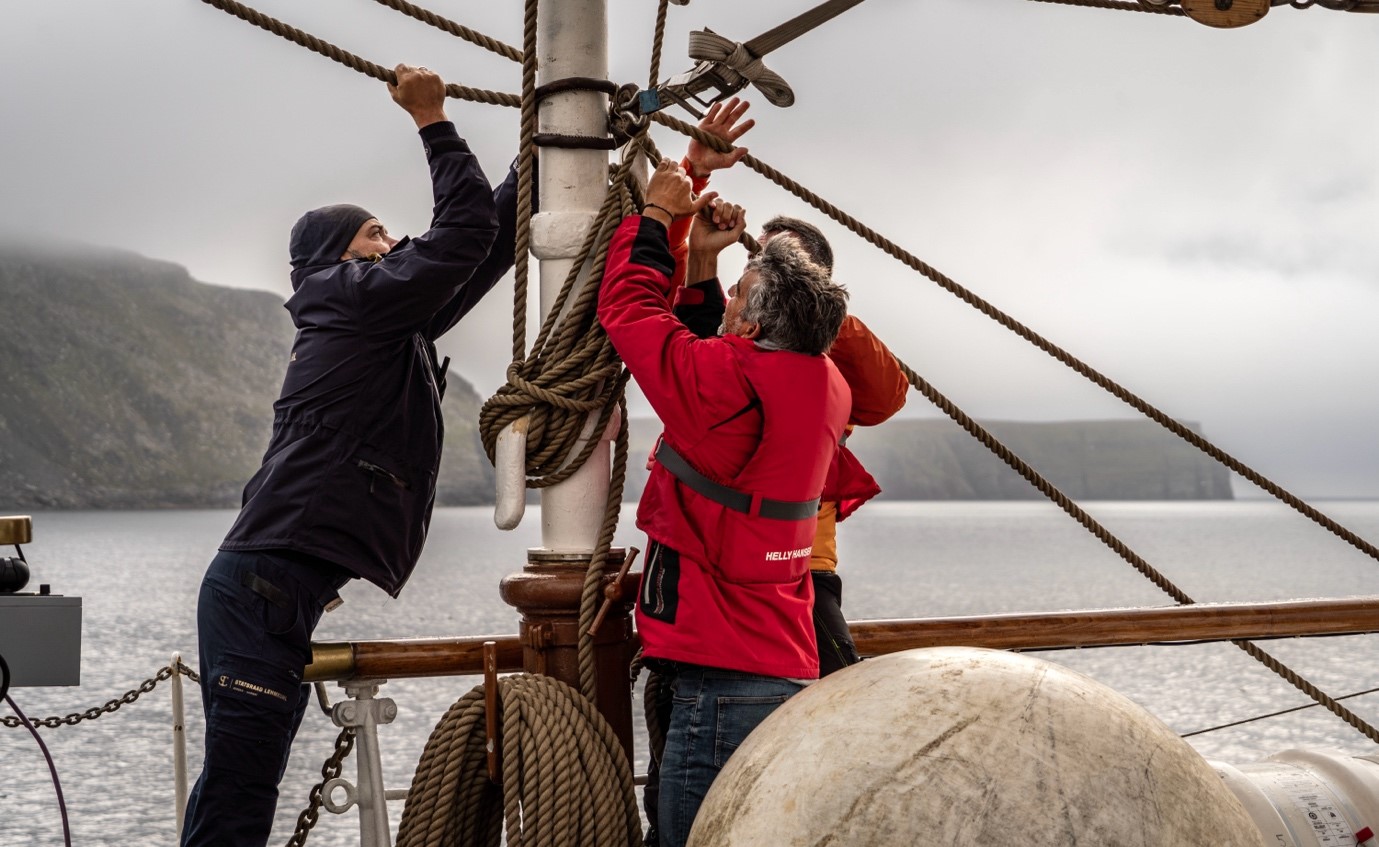
Blue Watch – the scientists – learning the ropes.
RED THREADS
Frustrated by the persistent theft of sailing ropes from their vessels, it is said the British Navy of the late 17th century introduced a solitary red thread running through all its cordage to enable easy identification – and return. And, no doubt, punishment. The red thread of today is a metaphor applied to every conference, workshop and negotiation; no longer the ‘rogue’s yarn’ as it was once named, but the one common thread amidst thousands of others intertwined and woven into that one hefty rope. The punishment today lies in failure to recognise it as the strongest and possibly only tie which offers continuity and integrity from one end to the other.
As this workshop-voyage set off, could one red thread emerge from the scientists’ discussions, one common approach to persuading politicians to listen and to act?
But ‘Blue Sky, Blue Sea’ thinking would also be a luxury on this voyage, to be achieved between watches, as these barely able seamen and women had their duties to fulfil. Keeping fire watch, buoy watch (a more palatable description for ‘man overboard watch’); steering the ship, clearing the decks, washing the floors, not to mention the physical demands of enabling a sailing ship to pick up speed, change direction, ride the waves. And never mind the anxiety of managing a hammock, clambering in as it rocks on its hooks from the ceiling, wriggling out again as it swings in tune to the swell of the sea, nudging the elbows, feet or face of too many immediate neighbours. Not enough sleep. No private space at all. For a week. A lifetime.
Many quietly stressed over the looming dread of seasickness ‘First you think you are going to die, then you hope you are going to die’ proffered one marine engineer. There was even a scientific explanation of how best to use the sick bins….port or starboard, depending on the prevailing winds.
But for all the disquiet, it turns out that heaving-ho on a rope together to see the sails unfurl is a great bonding experience; hauling the sails in again with chants and songs really does create an instant camaraderie. Climbing the rigging is a test of resolve for some, but there is no compunction to do so. These are the actions that make a sailing ship sail. But they are equally the actions which create a community like no other between folk who are obliged to step away from the comfort of their routines and live cheek by jowl for the duration of the journey.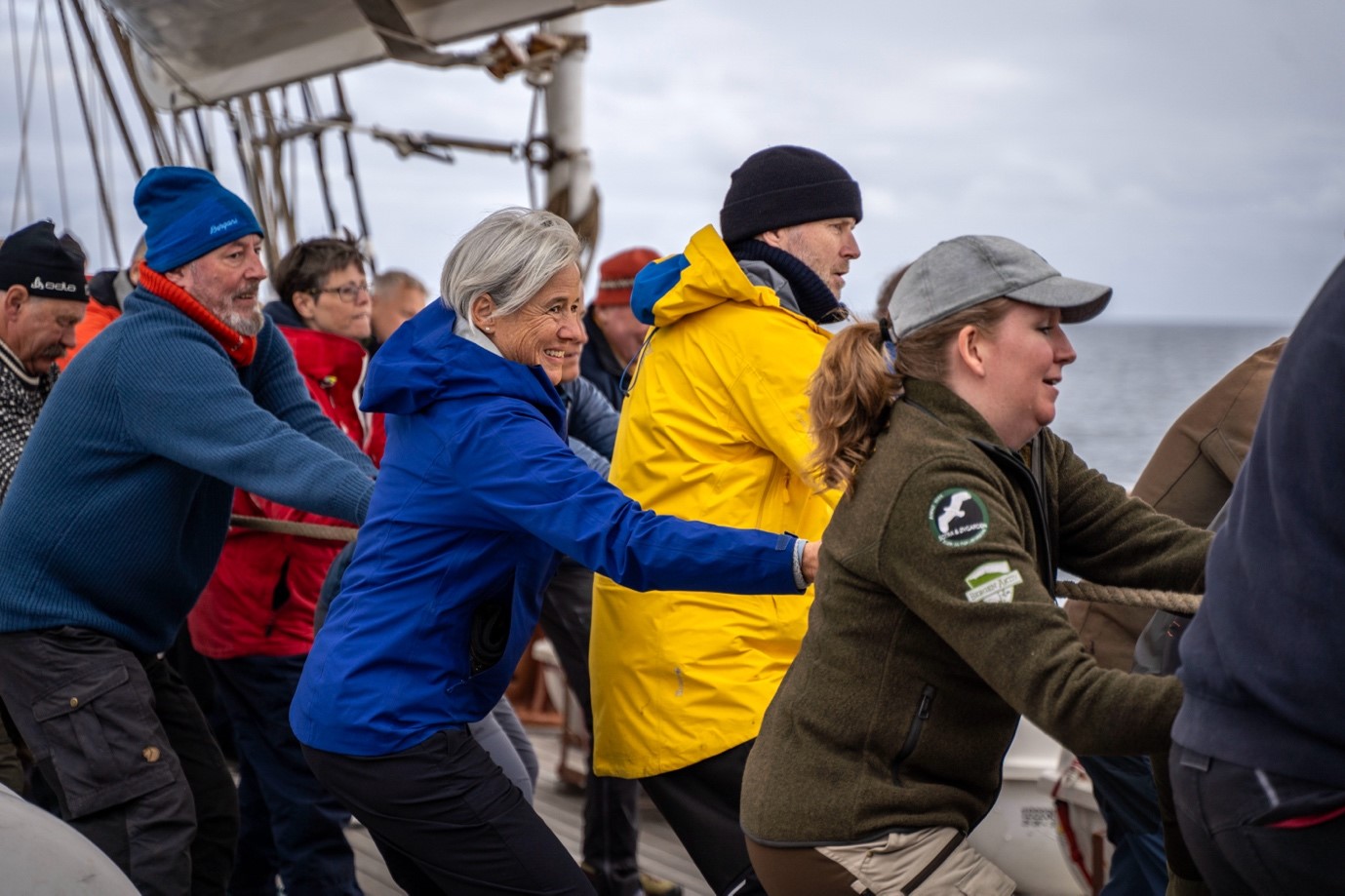
Pulling the ropes. Photo: Malin Kvamme.
Once they were off-watch, the scientists huddled in corners of the ship in search of inspiration and more effective ways of pushing The Ocean Agenda. When the sun shone – not often – they stretched out on the fore and aft decks; when it didn’t they struggled in the murky midships galley, unable to hear each other properly, with that persistent motion unsettling moods and occasionally thoughts. Difficult conditions bring out the best and worst in people….brainstorming on a boat is no exception, scientists are no exception. Frustrations grew in the search for an ultimate agreement. Disagreements emerged even where they weren’t being sought, on everything from strategy to the correct definition of a single word.
Scientists need precision in their language. Their disciplines and their way of thinking demand it. Clear, catch-all slogans don’t tend to cut it. The UN has launched a Decade of Ocean Science for Sustainable Development, with a catchphrase ‘The Science We Need for the Ocean We Want’. It works for most of us, but not always for those who question what that precisely means. What IS science? What IS a scientist? When is ‘knowledge’ a better description than ‘science’? These were not questions I was expecting to encounter.
In one break during lookout watch, I asked innocently enough if it was correct to say that 71% of the earth’s surface was covered in water, as popular estimates would have it. ‘Well that depends,” was not the confirmation I was looking for. ‘Yes’ would have done nicely. Or even ‘there or thereabouts’. What I got instead unravelled swiftly from an explanation of area versus volume, to the density of lifeforms in the Amazon Rainforest’s higher canopies. Woah. How do you sell that answer to a prime minister trying to calculate the best vote-catching strategy to pin to their mast?
The joy of the exercise is that scientists know they have an issue here. One of them mischievously offered me her own characterisation of the Lehmkuhl expedition we were all on: ‘I would bracket this as a ‘Type 2 Fun Oasis’, she said. That’s clear then.
Of course, there is in fact a formal Fun Scale, as only a scientist would know. Its origins are a little murky but the definitions are clear enough: Type 2 Fun is defined as ‘not actually fun in the moment, but when it’s over your memory erases the miserable parts and you would do it again – for fun, of course’. Now that IS clear.
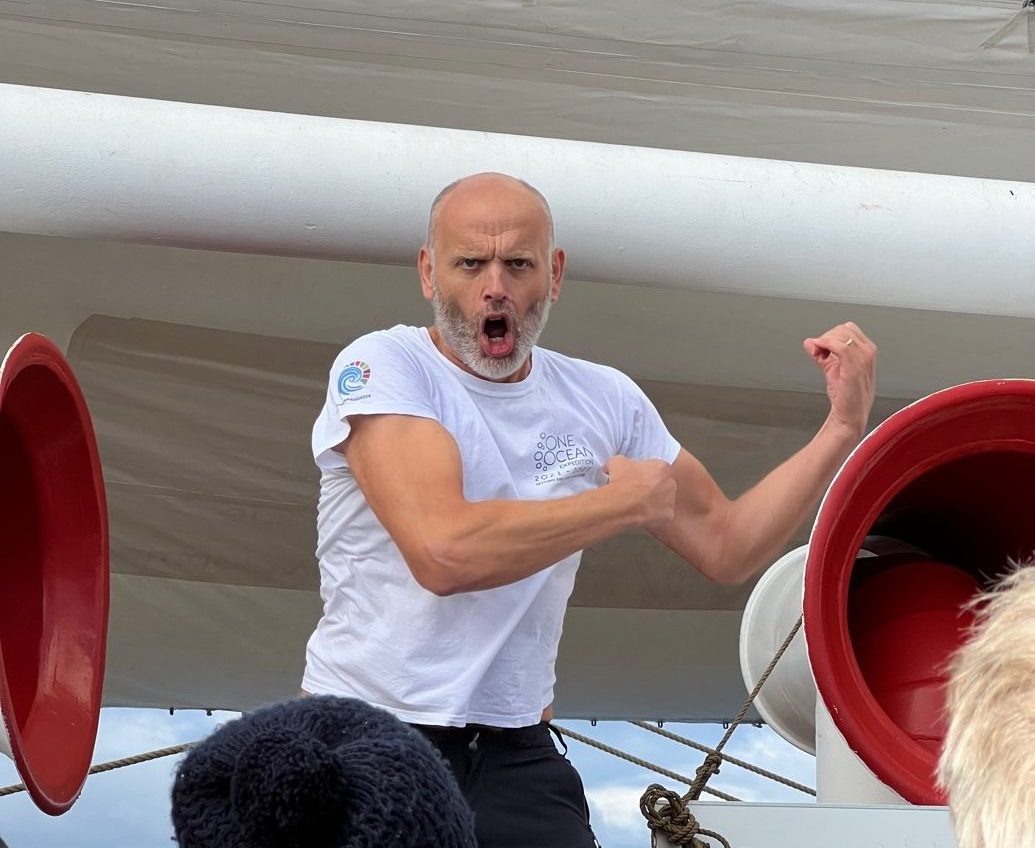 Vatle the Shantyman
Vatle the Shantyman
SHANTYMAN POLITICS
The best parts of crewing a ship may qualify as Type 1 Fun – think bracing, crisp breezes, billowing sails, exhilarating views. More often it is a slightly tedious, repetitive process, accompanied by an uneasy fog of nausea or vertigo. That can challenge even the most enthusiastic sailor. So the need for distractions is clear. And the sea shanty was invented for times like this.
The shanty is an artform. With special powers. Haakon Vatle, the only person with a Masters degree in the study of the sea shanty, explained their significance for the crew. ‘The rhythms are to chime with the heaving and ho-ing of the ropes, or the weighing of the anchor’, he explained. The verses reflect the realities of life on and offshore. And it is more than just fun. ‘What Shall We Do With The Drunken Sailor’ may be a universal take of a typical sailor’s story. But other shanties can spell out some harsh realities of life on board.
‘The Shanty Man is a political spokesman,’ says Vatle. ‘He – and he alone – has the capacity to relay to the captain how the crew are feeling. If the food is rotten and the cook is dreadful, the shanty will spell it out. If the captain is rotten and their treatment is dreadful, the Shantyman can ensure nobody sings at all.’ Shantyman as Influencer.
The scientists concocted their own shanty on this voyage. ‘Take No Initiative’ sung to the tune of ‘Do You Know the Muffin Man’ – some insisted it was more like ‘Centerfold’ by the J Giels Band. A witty take on life on board, or perhaps a semi-conscious attempt to let the captains of their world know that Progress on the Ocean is being stifled through the lack of initiatives and leadership being taken at the top. Maybe also a recognition of their own shortcomings, as their own cobbled path from scientific discovery to positive political action is often so encumbered by their own disconnected, self-absorbed approach.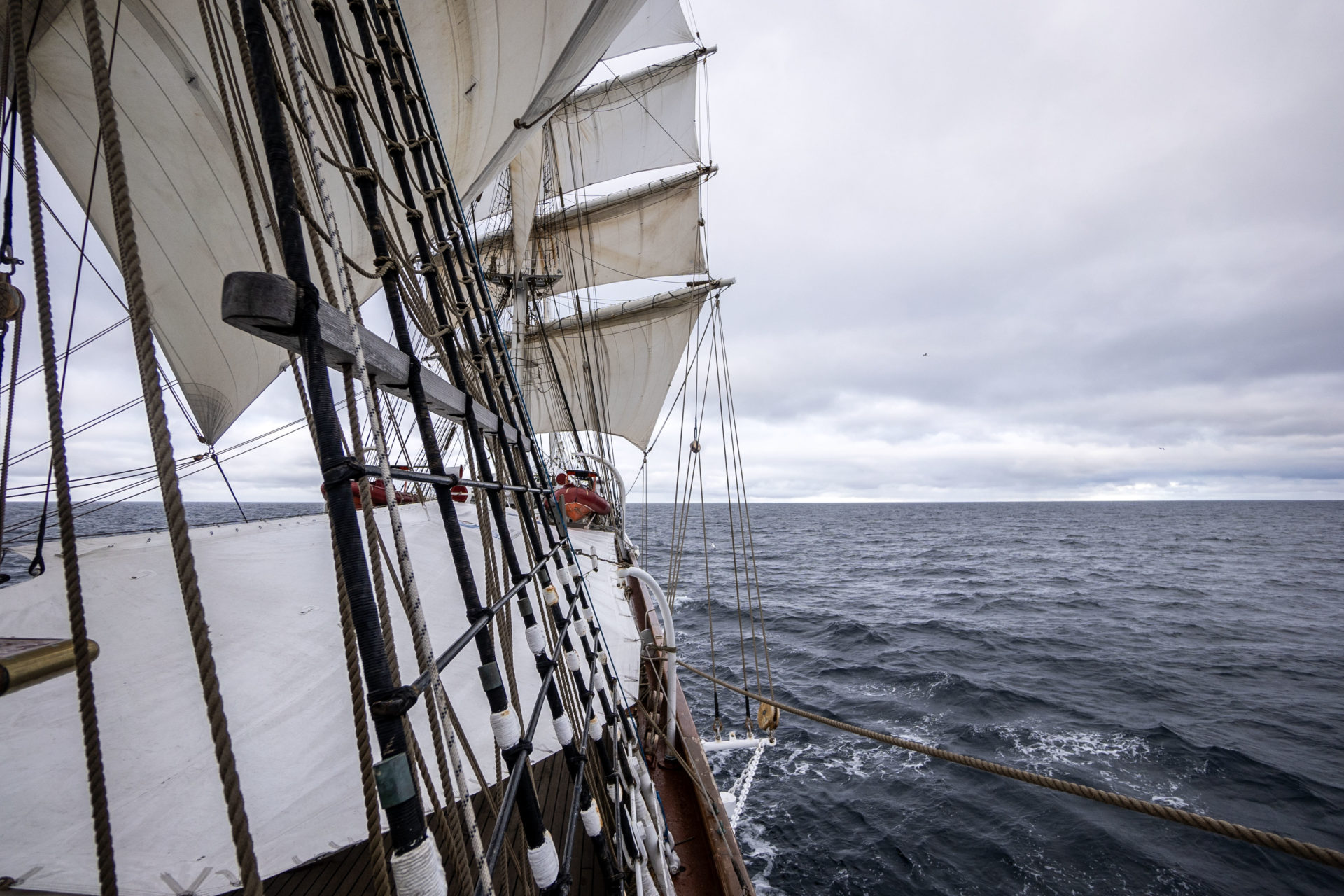
Photo: Malin Kvamme
It all points to some dark clouds ahead – and heavy going – in the battle for hearts and minds. And there is rarely such a thing as a smooth week in the North Sea. But this time the Statsraad Lehmkuhl was carried on gentle sea breezes, the swell almost non-existent. Seasoned crew remarked that they had never known such plain sailing on reputedly one of the most treacherous and choppy of seas with its shallow depths, and push-me-pull-you currents. It was a feelgood factor, which certainly helped.
The first clear indication of whether this maritime laboratory had made any real mark on its guinea pigs would surface within hours of a return to shore. Colleagues keenly shared information on the state of the seas which carried the Statsraad Lehmkuhl to Shetland and back. It transpired that we had just been sailing in waters that were more than 8% warmer than the average August temperatures over the last 30 years. (1) I feel bound to add that figure was contested by one or two of the scientist crew as an inaccurate measure. (What else would you expect?)
A common view emerged too of the vital necessity for sharing their knowledge with what they call the ‘global south’, providing open access to information gathered on ocean currents, temperatures, migration habits. And that they could do this within a framework of issues already laid out by the UN’s Decade of Ocean Science. (2) That includes the obvious, such as tackling marine pollution, and protecting fish stocks, or expanding the Global Ocean Observing System. Other key objectives are less obvious, such as changing humanity’s relationship with the Ocean.
But this ‘Decade of Ocean Science’ is their red thread for ocean protection.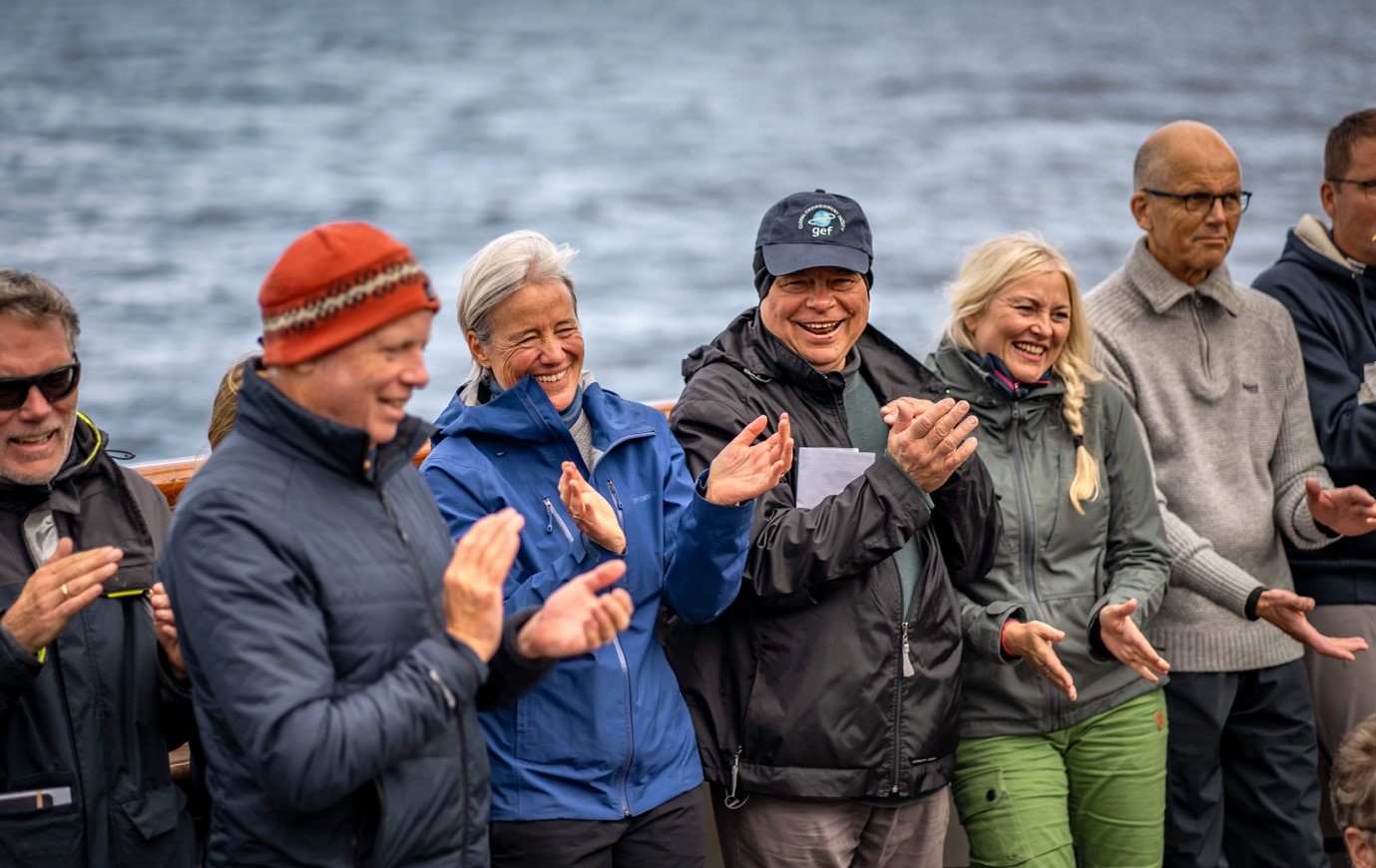
Photo: Malin Kvamme
And alongside the clever stuff, the data-gathering, the interpretation, the knowledge expansion, came the emotional learnings: that pulling together works. Shared experiences help. The hammocks, the rope coiling, the rigging, the watches, the sea shanties – even the seasickness, all played their part. Collectively they established a team effort that could not have emerged from any standard workshop or conference. And for every staging post to Nice 2025, ministerial meetings, national conventions, conferences, campaigns, they are committed to coordinating their disparate messages, breaking out of their silos and pursuing the common goal of ocean protection. A reunion and further attempt to consolidate their thinking is already taking shape for the UN Ocean Decade Conference in Barcelona next April.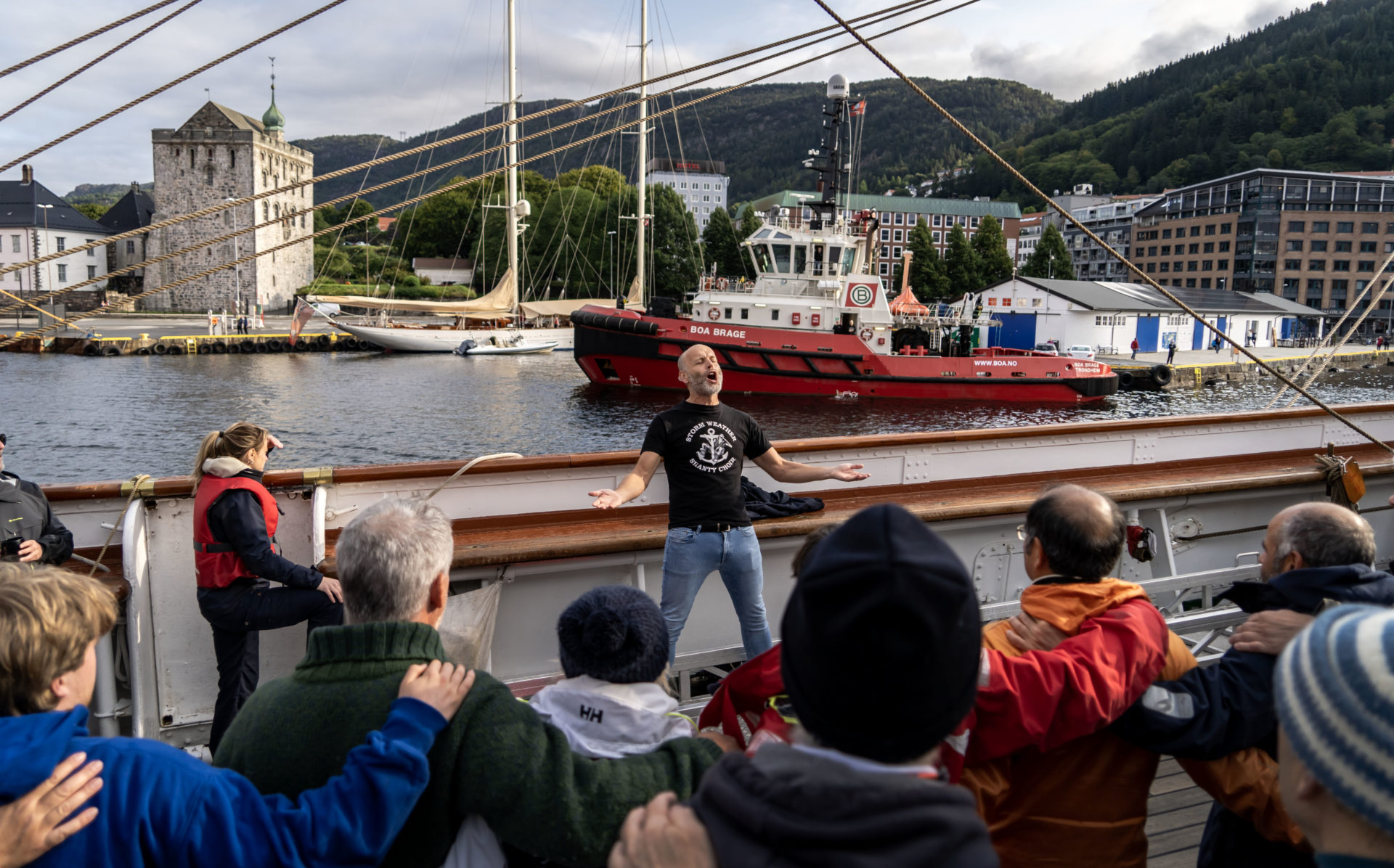
Arriving Bergen. Photo: Malin Kvamme
As the tall ship returned to the calming waters of Vestland County on Norway’s west coast, gliding towards the harbour of this ‘Capital of Fjord Norway’, Haakon Vatle heaved all the crew into action one more time, to bring the Statsraad Lehmkuhl home to the strains of a shanty lament – a song to capture the exhaustion of a long voyage, the aching desire to return home, mingled with the melancholy of a journey drawing to a close. It was only a short voyage away, but a few days on the seas really does feel like weeks on land.
‘This ship changes people’, says Haakon Vatle. ‘Maybe only a little. But your life is never quite the same after a voyage.’
They may need to build on their agreed approach but they do now have an approach to work with. For every staging post to Nice 2025, they are committed to coordinating their disparate messages, breaking out of their silos and pursuing the common goal of ocean protection.
2025 is a clear target. Not a final destination. Because this is a journey which has no end.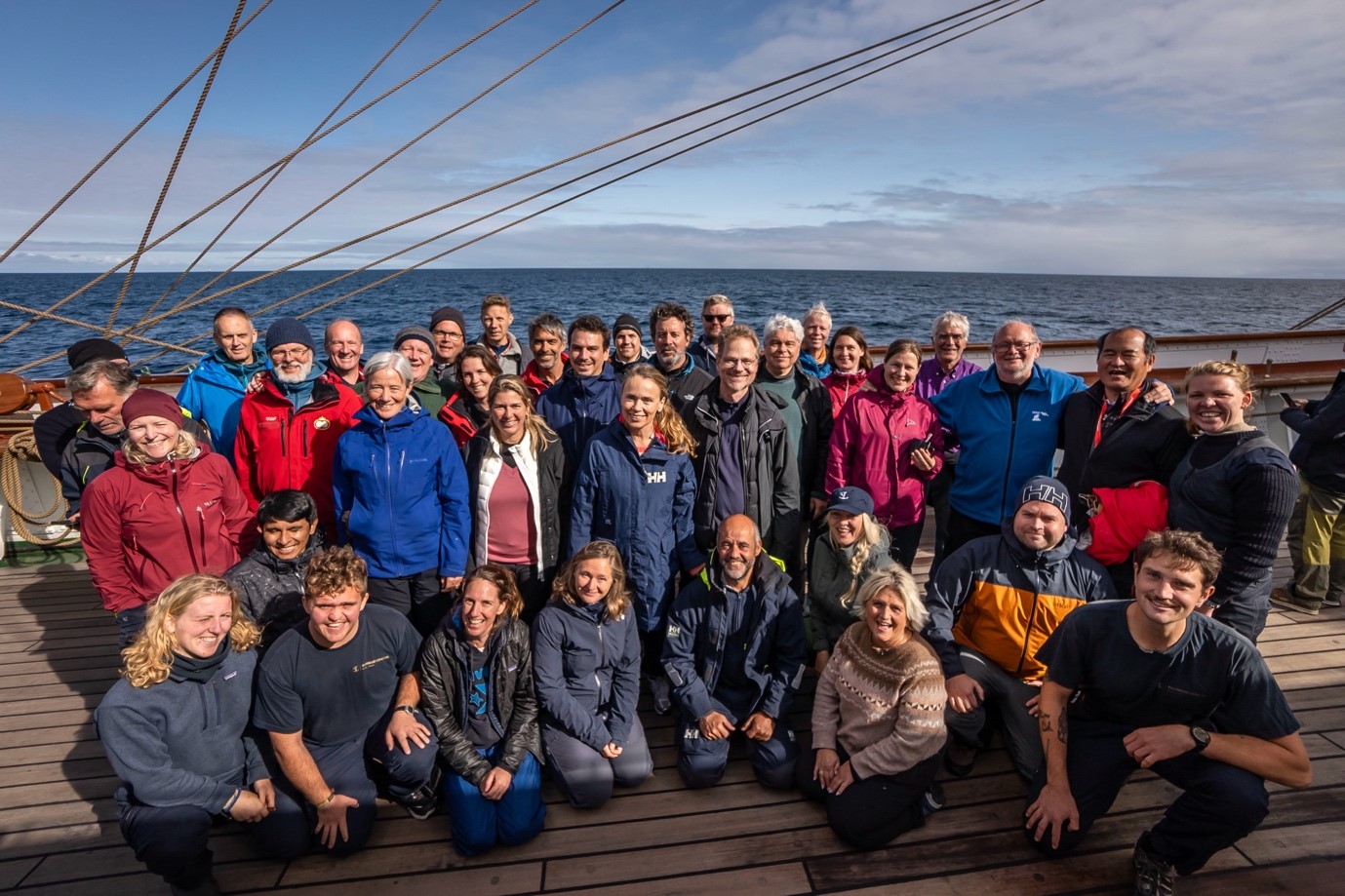
The blue watch
The homecoming shanty
‘Leave her, Johnny, leave her,
Leave her Johnny, leave her.
For the voyage is done
And the winds don’t blow,
It’s time to leave her now’
Statsraad Lehmkuhl at port in her home town Bergen, Norway. Photo: Gjermundphotography. All rights reserved.
2) The Intergovernmental Oceanographic Commission is a UN agency responsible for the ‘UN Decade of Ocean Science for Sustainable Development’, which will run to 2030. It has defined ten challenges for the decade:
Understand and beat marine pollution
Protect and restore ecosystems and biodiversity
Sustainably feed the global population
Develop a sustainable and equitable ocean economy
Unlock ocean-based solutions to climate change
Increase community resilience to ocean hazards
Expand the Global Ocean Observing System
Create a digital representation of the ocean
Skills, knowledge and technology for all
Change humanity’s relationship with the ocean
Read more about the UN’s ocean decade here
1) Data gathered and provided by Mercator Ocean International:
MOi is a non-profit organisation, providing ocean science-based services of general interest focused on the conservation and the sustainable use of the oceans, seas and marine resources. MOi has developed complex ocean simulation systems (numerical models) based on ocean observation data (satellite and in situ) that are able to describe, analyse and forecast the physical and biogeochemical state of the ocean at any given time, at the surface or at depth, on a global scale or for a specific zone, in real-time or delayed mode.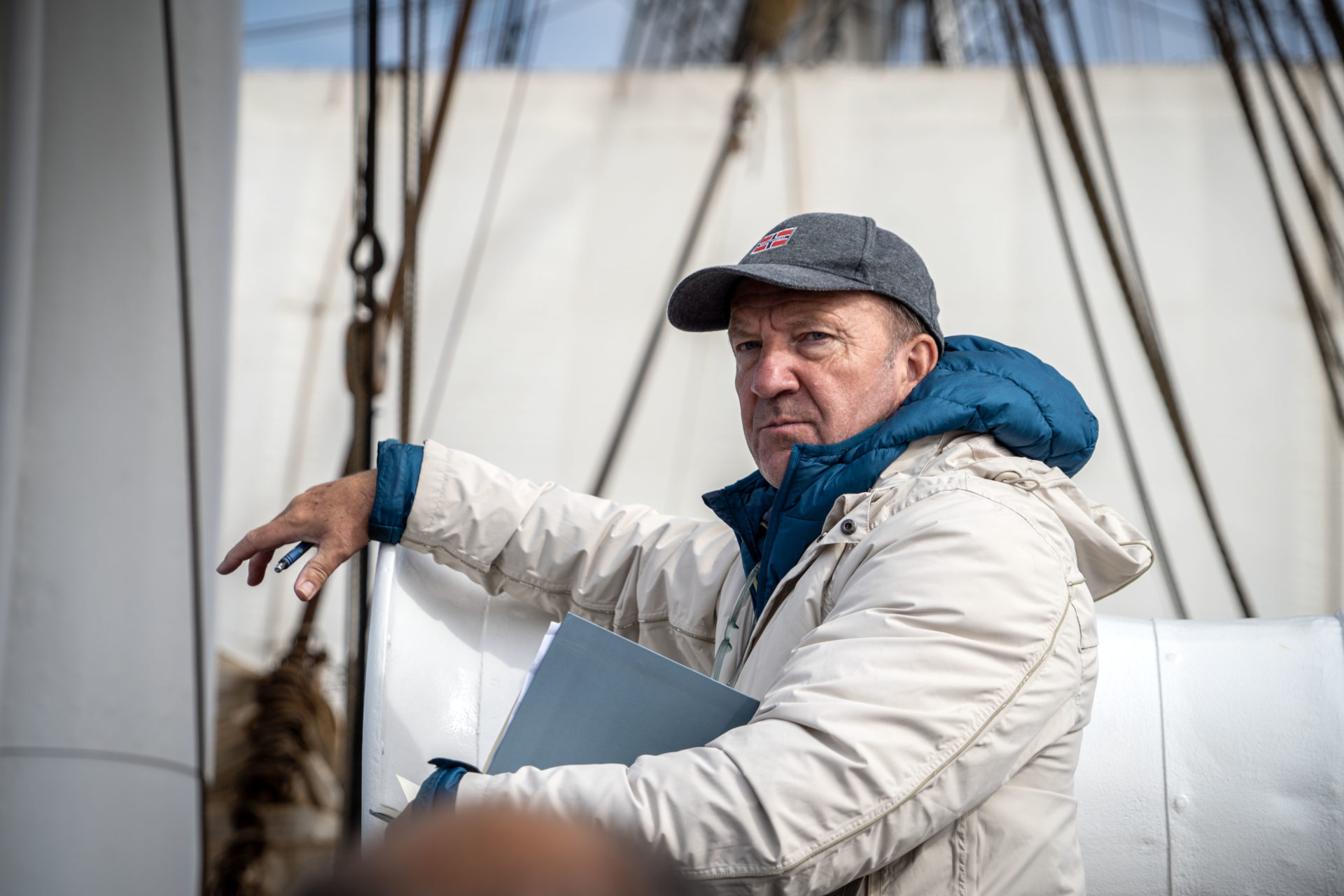
David Eades is a former BBC TV and Radio News Anchor. He has taken a special interest in
Protection of the Ocean. Photo: Malin Kvamme
